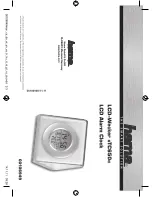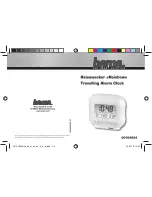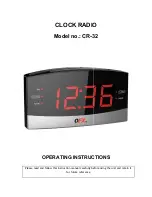
Version 1.0
©Copyright 2015, Ambient LLC. All Rights Reserved.
Page 5
The clock will begin updating again after the
M. SET
button has not been pressed for two minutes.
The clock will attempt synchronization every two hours (1:00, 3:00, 5:00, 7:00, 9:00, 11:00, 13:00,
15:00, 17:00, 19:00 and 21:00). During synchronization, the second hand will operate properly.
10
Forced Radio Resynchronization
To force resynchronization from the atomic clock, press and hold the
REC
button for 3 seconds. The
hands will return to the 12:00 position.
The clock attempts to synchronize with the atomic clock for 12 minutes. If it synchronizes, the clock
sets properly. If it does not receive the signal from the atomic clock (very likely during the daytime),
the clock will begin running from the 12:00 position until the time synchronization is successful.
The clock will attempt synchronization every two hours (1:00, 3:00, 5:00, 7:00, 9:00, 11:00, 13:00,
15:00, 17:00, 19:00 and 21:00). During synchronization, the second hand will operate properly.
11
Maintenance
The device is maintenance-free, but should be cleaned occasionally. Only use a slightly dampened and
soft cloth to clean the housing. Do not use abrasives or solvents.
12
Specifications
Operating Voltage
1.5 Vdc
Battery
1 x AA
Battery Life
About 1 year (high quality batteries)
Radio controlled time protocol
WWVB (USA)
Dimensions
Approximately 12”
13
Glossary of Terms
Term
Definition
DST
Daylight saving time (DST) or summer time is the
practice of advancing clocks during the lighter months so
that evenings have more daylight and mornings have
less. Typically clocks are adjusted forward one hour near
the start of spring and are adjusted backward in the
autumn.
RCC
A radio-controlled clock is a clock that is synchronized
by a time code bit stream transmitted by a radio
transmitter connected to a time standard such as an
atomic clock.
WWVB
WWVB is a NIST time signal radio station near Fort
Collins, Colorado. WWVB is the station that
radio-controlled clocks in most of North America use to
synchronize themselves. The 70 kW ERP signal
transmitted from WWVB is a continuous 60 kHz carrier
wave, the frequency of which is derived from a set of
atomic clocks located at the transmitter site, yielding a
frequency uncertainty of less than 1 part in one trillion.


























